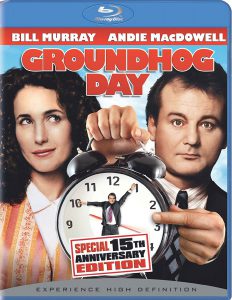Here are 10 random observations about one of the greatest comedic dramas – or dramatic comedies – of all time: “Groundhog Day” (1993). I’ll try to not make the list too repetitive.
1. Offhand, I can’t think of another movie that redefined a holiday to the degree “Groundhog Day” did. Before the film’s release, Groundhog Day was about a rodent seeing or not seeing its shadow and predicting a longer or shorter winter. After 1993, it also meant a day that repeats in an endless loop. This was made possible by a minor holiday paired with a great movie. It doesn’t work with a major holiday and good movie (“Independence Day”) or a minor holiday and unheralded movie (“Leap Year”). That having been said, it’s not random that this story is set on Groundhog Day, as Punxutawney Phil’s life of emerging once a year to perform the same task (and on a dreary winter day, no less) mirrors the Channel 9 crew covering the festival and metaphorically reflects how some people feel about their lives. Indeed, when Phil tells to a local hick in the bar that all his days are identical and meaningless, the local unironically says “That about sums it up for me.”
2. “How many days does Phil spend in the time loop?” is a popular question among film geeks. The DVD chapter titles purport that six days pass, but really we’re just seeing six distinct lessons that Phil learns. Within each of those “days,” we often see multiple versions of a scene. Beyond that, many more days are implied; for example, Phil needs a certain amount of time to master piano playing or ice sculpting, and probably many more to learn how to say the right thing to Rita. Thankfully, the math has been done for us: WhatCulture performed a detailed analysis of the movie and found that Phil spent 12,395 days — just short of 34 years — in the time loop.
3. Among the more philosophically inclined, a popular question is “Did Phil truly change, or did he just learn how to behave differently?” There’s no question that changing his outward behavior impacts the way other people – particularly Rita — see him. Since Phil likes Rita, he is willing to put in the 34 years’ worth of effort to get her to like him. Reading the film in a spiritual sense, the ending confirms that Phil did indeed change: He gets to move on to Feb. 3 now that he has become a good person. There is no blunt moment or action that makes the last day notably different than any previous day; as such, a viewer has to assume Phil changed on the inside to a sufficient degree for the gods of time to grant him his release from the time prison.
4. Andie MacDowell’s character, Rita, is a troublesome (and oddly fascinating) part of the movie. Obviously, she serves as an objective goal for Phil – a motivation for him to change. And, on the surface, Rita is a nice, likable person, just as Phil describes her. However, Rita also has a dark quality that’s hard to square with her surface traits. Early in the film, she – and all of us viewers – sees Phil’s outer meanness and cynicism, but she doesn’t judge him too harshly for it; she even tries to be friendly to him. As the film progresses and Phil gradually becomes a better person, Rita becomes LESS capable of seeing his inner goodness. She judges him entirely on his outward behavior. It’s not until he behaves exactly the right way and says exactly the right thing that he wins her over. One could excuse Phil if he started to think he deserves someone better than the harshly judgmental Rita. But obviously, it’s a case of true love; he had worked for 34 years to woo her.

5. Aside from being tripped up by Rita, I find the script by Danny Rubin and Harold Ramis (who also directs) to be brilliant. But the performance of Bill Murray pushes “Groundhog Day” to the next level. Every moment when I laugh out loud comes from Murray-isms. My favorite – dating back to when I saw the film on its theatrical release — is the sequence where Phil smashes the alarm clock with his fist, his facial expression completely blank from the moment he wakes up. “Groundhog Day” is one of my top three Murray films, and the other two – “Lost in Translation” and “Broken Flowers” – also find him doing a remarkable amount of acting with remarkably little change in his facial expression.
6. That having been said, whenever I hear the name “Ned,” I think of Stephen Tobolowsky’s enthusiastic run-in with Phil: “Ned. Ryerson! Needlenose Ned, Ned the Head …” And, of course, “Watch that first step. It’s a doozy!”
7. There were a handful of time-loop movies and TV episodes before “Groundhog Day” (in fact, the “Star Trek: The Next Generation” time-loop episode came out the year before the movie), but there have been a bevy of them since. Interestingly, “Groundhog Day” wasn’t accused of borrowing from previous stories, but pretty much every time-loop story since then is described in shorthand as a “Groundhog Day” riff.
8. “Buffy” used the time-loop trope twice. The episodes don’t precisely use the repeating-day scenario, but – similar to the film – Buffy has to figure out the secret to breaking the loop. “I Only Have Eyes For You,” where Buffy and Angel are possessed by ghosts of tragic lovers, is part of the block of heartrending episodes that close Season 2. And one of the segments of Season 6’s comedic “Life Serial” finds the Trio using magic to test Buffy. “Angel” also used a time-loop scenario in Season 5’s “Time Bomb”; every time Illyria blows up, the time cycle resets.
9. “The X-Files” used the trope in Season 6’s “Monday,” mixing drama and comedy. As with the “Groundhog Day,” Mulder repeats the single day referenced in the title; the difference is that he doesn’t clearly retain his memories. The dramatic hook is that Mulder has to defuse a bomb, but I mainly remember the episode for Mulder’s waterbed springing a leak at the start of every day.
10. “Groundhog Day” features not one, but two, earworms, which I suppose makes sense for a time-loop movie: One that gets old pretty fast, and another that totally holds up on multiple listens (within reason).
What are your favorite things about “Groundhog Day?” Share your thoughts below.


He spends 34 years in the loop?!? I never realized that.. I thought maybe a couple of weeks. Wow.
Yeah, it really gives you a new perspective on the film to realize he has tried to create the “perfect” day for 34 years’ worth of time. It enhances the movie’s undercurrent of loneliness (as he can’t share his experience) but also makes me kind of wish I could stop time for 34 years and just do whatever I want — catch up on books, TV and movies, or whatever.